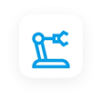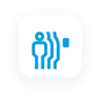According to ResearchAndMarkets.com, the port equipment market size is expected to grow from USD 29.2 billion in 2018 to USD 36.6 billion by 2025. The report also predicted that automation technologies in port equipment will become critical in improving the efficiency of various port terminal operations.
As the need to automate port and crane applications increases, operators demand a reliable technology that will allow the vehicles and equipment to navigate a complex physical environment and avoid obstacles. The incorporation of LiDAR sensors into various port terminal and robotic equipment plays a key role in such automation technologies.
What's LiDAR and How Does a LiDAR Sensor Work?
LiDAR stands for Light Detection And Ranging. A device with a LiDAR sensor sends out lasers that bounce off objects and return to the source, then calculates the distance by measuring the time it takes for the light pulse to travel.
When a LiDAR device sends out a spray of infrared or ultraviolet beams that are invisible to the human eye, it measures each one with its sensor and creates a field of points. It then creates a two or three-dimensional map of the space while detecting the motion of the objects in its vicinity.
LiDAR is used in many devices and equipment that need to operate autonomously within a three-dimensional space. For example, the technology is used for obstacle detection in autonomous mobile robots (AMRs), industrial automated guided vehicles (AGVs), agricultural vehicles, mining equipment, as well as port and crane automation applications.
The Benefits of Using LiDAR in Port and Crane Automation
Among the many applications, LiDAR sensors are widely used to support port and crane automation applications in port terminals. They can be found in automated guided vehicles (AGVs) and internal terminal vehicles (ITVs) for transferring freight within a port, container handling equipment that manages loading and unloading, as well as terminal security and yard monitoring systems to provide real-time status on containers and port equipment.
Today's LiDAR sensors can deliver accurate real-time data on people, objects, and port infrastructure. They provide a wide-angle field of view and high resolution required by autonomous equipment to synchronize and optimize logistics movements.
The use of LiDAR sensors helps ensure that autonomous vehicles can navigate safely and efficiently throughout a port under a variety of conditions without the need for specialized infrastructure. Meanwhile, LiDAR sensors used in yard cranes, truck positioning cranes, etc. facilitate the loading and unloading process to minimize port stays by ships.
The automation technology also improves equipment reliability and safety while lowering labor and operating costs. For example, LiDAR sensors enable automated crane steering for efficient ship-to-shore bulk handling and safer operation of gantry cranes by reducing collision risks.
Smart LiDAR sensors allow vehicles and self-driving systems to bring greater precision to terminal operations by determining the safest way to navigate and coordinate the movement of various vehicles in complex and busy ports. The increase in efficiency can further reduce operating costs by reducing the overall size and maintenance needs of a fleet.
Incorporating LiDAR Into Port and Crane Automation
Using the right LiDAR sensor ensures that your automated port terminal equipment can operate safely, efficiently, and reliably. For example, Hokuyo's UGM-50LAP is an outdoor-rated 2D LiDAR sensor designed for obstacle detection in various port and crane automation applications.
The UGM-50LAP LiDAR scanner offers three configurable area output zones to capture the desired distance data in a 190° field-of-view for up to 120 meters. It's equipped with an Ethernet interface for real-time data transmission while the IP67 shock-resistant aluminum housing and built-in heater ensure that the sensor can provide reliable object detection and profile measurement in challenging ambient conditions for indoor and outdoor applications.
You can install multiple sensors within a piece of equipment and synchronize the rotation of the motors to an external reference signal to minimize interference among the units while increasing range and accuracy. The sensor has a contamination detection feature for monitoring dirt build-up on the lens and a built-in heater that prevents dew condensation on the optical window.
Our collision-avoidance sensors, obstacle detection scanners, optical data transmission devices, laser rangefinders, and more have been trusted by OEMs, end-users, integrators, R&D firms, and manufacturers thanks to our reliable technology, comprehensive product distribution, and unparalleled service and support. Get in touch to learn more about our smart LiDAR sensor.

 Factory Automation
Factory Automation Logistics Automation
Logistics Automation Process Automation
Process Automation Crane Collision Avoidance
Crane Collision Avoidance LiDAR/Obstacle Detection
LiDAR/Obstacle Detection Safety Laser Scanners
Safety Laser Scanners Optical Data Transmission
Optical Data Transmission Hot Metal Detectors
Hot Metal Detectors Laser Distance Sensor
Laser Distance Sensor Blog
Blog Whitepapers
Whitepapers Case Studies
Case Studies Infographics
Infographics